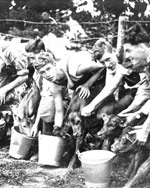SCHEYVILLE TRAINING FARM 1911-1939
Henry Field, Dreadnought boy 1925. 1
The removal of children and teenagers from Britain to its Empire has a long history. Although today it appears a callous uprooting of vulnerable adolescents, during most of the 20th century child migration was popular in Australia for boosting population without importing competition for adult jobs. It was supported in Britain for providing opportunities for young people and promoting Empire solidarity. The main child migration organisations were the Big Brother Movement and the Dreadnought Trust.
The Dreadnought Trust was established in 1909 when a meeting at Sydney Town Hall resolved to raise money to purchase a battleship for the British Navy. The meeting agreed that 'the time has arrived for the Commonwealth to take an active share in the naval defense (sic) of the Empire'. Britain and Germany were engaged in an escalating arms race. Battleships – 'dreadnoughts' in the contemporary vernacular – were the major currency in an increasing rivalry which culminated in the Great War of 1914-18.
However the Australian Government decided in 1910 to establish an Australian navy, rendering the subscription irrelevant. A large part of the £90,000 raised was placed in a fund to bring British boys to Australia for training and assignment as rural workers.
Harold Rawson, Dreadnought boy, 1925.2
Contemporary Australian culture is composed of a myriad of nationalities, however until the 1970s migration was regulated by the restrictive immigration policy known as the 'White Australia' policy. During the 1920s and 1930s migrants came primarily from England, Scotland and Ireland.
Harold Rawson, Dreadnought boy, 1925. 3
The boys were at work by 7.30am and worked until 5 pm. They worked at clearing land, milking, ploughing and extending the area under cultivation. The farm was self-sufficient in food, with its own vegetable gardens and fruit orchards, dairy, cattle and sheep herds.
Most of the 15 to 19 year olds were from urban backgrounds. They had a lot to learn practically but the personal and cultural changes were usually the most difficult and poorly appreciated. It was widely believed at the time that city life created moral and behavioural failings among the young, and that 'rescue' from such conditions was esirable. Add to this the pitiful fact that in all countries there is a tendency for the rural population to crowd into towns...and you have the most excellent and urgent reasons why every city lad who is desirous of going into the country should be given some training, and some assistance.4
The wages low, conditions tough
At milking cows we found employ
Most Cockies had a Pommy boy
From a poem by Dreadnought Boy Tony Kibblewhite 5
The emotional consequences of individual exile from family and familiar places were not recognised. Many Dreadnought boys were quick to reject their role as cheap farm labour, moving to the cities and their greater opportunities.
Gilbert Jackson, Dreadnought boy 1925.6
Accommodation was basic for the first two decades, consisting of timber and iron dormitories and other buildings. The more commodious quadrangle building replaced many of the original structures in 1929. Of the early farm buildings, only one silo is still standing.
Dreadnought numbers were in decline by 1929, affected by adverse publicity of harsh conditions on Australian farms. The Age newspaper, for example reported on 'deluded immigrants, attracted by Dreadnought advertising which presented Australia 'as a land of health, wealth and success', only to find themselves 'practically penniless' at Glen Innes.7
The Dreadnought scheme was suspended during the economic Depression of the early 1930s. It was partly reinstated after 1935, with unemployed Australian city boys gaining most of the farm training. However child migration flourished after 1945. The Big Brother Movement and several church organisations sponsored the migration of British teenagers during the 1950s and 1960s.
During the 1939-45 war, Scheyville was used as a military training camp. The 73rd Australian Anti-aircraft Search Light Company and later the RAAF 244 1st Parachute Battalion were based at the farm.
Notes:
1. Interview by Margaret Miller 1987, Oral History collection, National Library of Australia, ORALTRC2301/18.
2. Interview by Margaret Miller 1987, Oral History collection, National Library of Australia, ORALTRC2301/95.
3. Interview by Margaret Miller 1987, Oral History collection, National Library of Australia, ORALTRC2301/95.
4. Report of the State Labour Bureau of NSW, 1912, Sydney, Government Printer, 1912.
5. Alan Gill, Likely Lads And Lasses: Youth Migration To Australia 1911-1983, Sydney, Big Brother Movement, 2005.
6. Interview by Margaret Miller 1987, Oral History collection, National Library of Australia, ORALTRC2301/94.
7. The Age, 14 February 1922.



